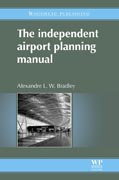
This manual provides airport planners with an essential guide and reference, based on the author’s extensive experience in the field and best practice guidelines used by the International Air Transport Association (IATA) and the Airport Council International (ACI). An accompanying CD is provided to enable airport planners and architects to design the common building blocks when masterplanning the size and form of the terminal building complex. Chapter 1 discussesthe key issues airport planners need to account of, including forecasting demand, planning and strategic objectives, physical site constraints, airport security and the characteristics of terminals, satellites and piers. Chapter 1 also discusses cargo and aircraft maintenance facilities, general airfield infrastructure, landscaping and access provision. Chapter 2 defines the outline planning principles associated with the IATA industry standard best practice tenstep plan for masterplan development together with the various types of masterplan evaluation techniques. The chapter includes a case study and template thatcan be used for decision-making. These chapters provide a context for the remaining chapters which discuss individual aspects of airport design. Chapter 3 focuses on the design of the terminal pier and satellite infrastructure, particularly in the context of effective passenger segregation. The chapter also discusses airside and landside retail facilities, including case studies as wellas reference calculations to define the areas for concourse and baggage hall space. Chapter 4 reviews baggage handling design, including the various categories of baggage handling system, user requirements and the pros and cons of different baggage handling technologies. Chapter 5 covers apron design, including such features as passenger airbridges and Multi-Aircraft Ramping Systems (MARS) for aircraft parking in the context of the needs of both low-cost and legacy carriers. Chapter 6 focuses on airport security, discussing potential threats to aircraft and airports, including the potential impact of explosives on airport infrastructure. The chapter also explains best practice for improving security in terminals, piers, satellites, car parks and forecourts as well as the airport perimeter. The final chapter comprises a series of airport case-studies, including airports processing predominantly and those that process predominantly legacy carriers. The case studies provide the designer with real examples of processes and layouts within airports. INDICE: The brief to airport planners; Outline airport planning principles; Airport terminal and pier/satellite planning; Airport baggage handling design; Airport apron, runway and taxiway design; Design for airport security; Case-studies in airport planning.
- ISBN: 978-1-84569-713-6
- Editorial: Woodhead
- Encuadernacion: Cartoné
- Páginas: 224
- Fecha Publicación: 01/09/2010
- Nº Volúmenes: 1
- Idioma: Inglés
